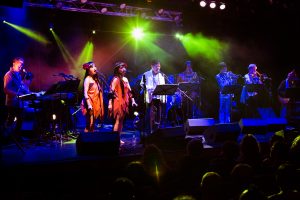JQ Magazine: Japan Society Salutes Godzilla with Concert Spectacular

Special guests Charan-Po-Rantan and Makigami Koichi (center) performed in Godzilla Legend — Music of Akira Ifukube at Japan Society on April 28. The concert was conceived and arranged by Makoto Inoue (far left) and performed by the band Hikashu and other special guest musicians. (Ayumi Sakamoto)
By Lyle Sylvander (Yokohama–shi, 2001-02) for JQ magazine. Lyle has completed a master’s program at the School of International and Public Affairs at Columbia University and has been writing for the JET Alumni Association of New York since 2004. He is also the goalkeeper for FC Japan, a New York City–based soccer team.
On April 28, the Japan Society of New York hosted a delightfully unusual concert of Godzilla music. Yes, you read that correctly. The Japanese pop techno band Hikashu took the stage in a 90-minute intermission-less night of monster music from such iconic classics of the Godzilla canon as Gojira (a.k.a. Godzilla, King of the Monsters!) (1954), Rodan (1956), Mothra (1961), King Kong vs. Godzilla (1962), Ghidora, the Three–Headed Monster (1964), Godzilla vs. Mechagodzilla II (1993) and Godzilla vs. Destoroyah (1995). While the colossal black-green (his color fluctuates from movie to movie) lizard never made an onstage appearance, he made his presence aurally known through Hikashu’s superb performances, with narration by founding member Makoto Inoue (who also played keyboards) and special appearances by the female pop duo Charan-Po-Rantan. Adding to the fun were aural appearances by the Big G’s nemeses, Rodan, King Ghidora, King Kong and Mothra, a gigantic butterfly-like insect who was the only monster to ultimately defeat Godzilla in battle.
Inoue’s narration did more than entertain; it also provided informative commentary on the evolution of the films. As Inoue explained, Godzilla was born out of the collective Japanese fear of both large natural disasters (earthquakes, typhoons and tsunamis) and of the atomic bomb. Produced just nine years after the bombings of Hiroshima and Nagasaki and one year after the U.S. testing of a hydrogen bomb contaminated a Japanese fishing vessel, the original Japanese film is a dark and somber affair. For years, the only available version in North America was a re-edited film that mixed a new English-language narrative with the Japanese monster footage—that film starred Raymond Burr and downplayed the ominous sadness.
Thankfully, the original has been restored and is available for home viewing through the Criterion Collection, so Americans can now see the serious themes with which director Ishiro Honda works. While film critics have rightfully recognized Honda’s aesthetic accomplishments, they have been slower to recognize those of composer Akira Ifukube. The “Main Theme”, which recurred throughout the evening, is a dirge-like march that changes meter and key while maintaining a constant ominous tempo. One can palpably feel the horrific Godzilla marching forward and destroying everything in his path.
As the series continued, the movies became less serious as it targeted a younger audience. Likewise, Ifukube’s music evolved to follow the new tone, which often featured outrageous battles between the rubber-suited monsters. Inoue’s arrangements highlight Ifukube’s eclectic mix, which delightfully combines jazz, ’60s-era psychedelic pop, tonal dissonance (possibly stretching into atonal territory) and traditional Japanese folk music. Inoue’s expert arrangements were superbly played by Mita Freeman (guitar), Masami Sakaide (bass), Kazuto Shimizu (synthesizer), Masaharu Sato (drums), Kogoro Tatsumi (trumpet), Ryuichi Yoshida (baritone sax), Atsushi Goto (trombone), Koichi Makigami (gong, theramin, vocals) and Inoue himself on keyboard. The duo Charan-Po-Rantan intermittently sang songs with the band, most prominently in the theme for Mothra. Adding to the ambience is the superb lighting design, which combines bright reds, primary yellows and cold blues filtered through onstage fog to create exotic locales and the otherworldly origins of the monsters.
The heightened theatricality of Godzilla Legend entertained both Godzilla novices and connoisseurs alike. As an example of the latter, the following was overheard after the concert: “Man, as each song played, I could recall and re-imagine the exact scene from that specific movie.” The night’s fusion of pop concert and theatricality may even provide a template for future Japan Society events: One imagines what could be done with an evening of music by Joe Hisashi (Studio Ghibli’s fabled composer) or more recent pop-oriented scores.
For upcoming events at Japan Society, visit www.japansociety.org.


Comments are closed.